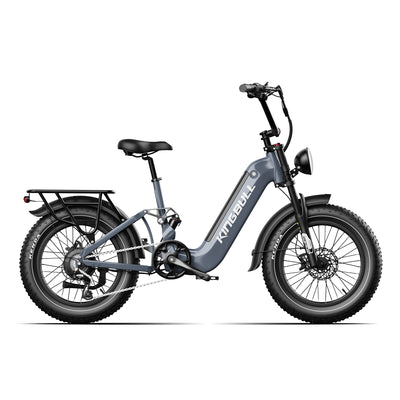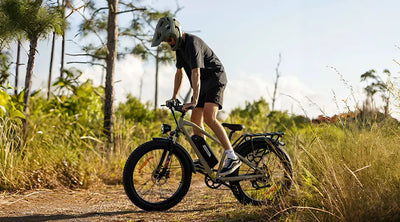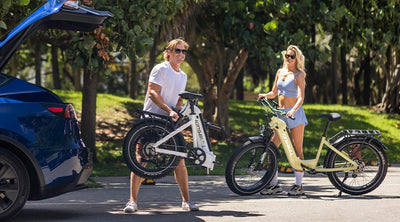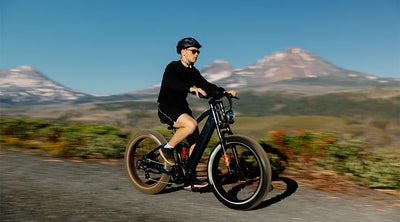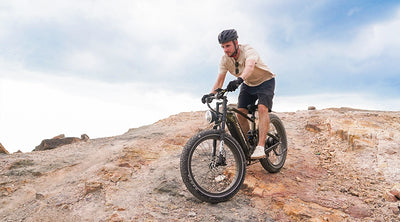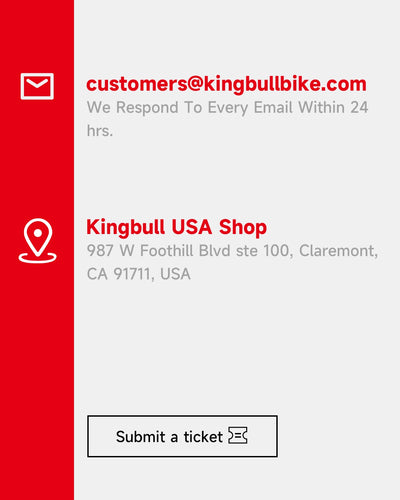Explore News

Kingbull NewsTips & Cycling Knowledge
Christmas Travel Guide: Make Your Holiday Sparkle with an Electric Bike
As the holiday season rolls in, many families are planning their Christmas getaways. Why not try something new this year? Bring an electric bike along for the ride! Whether you're heading out for a day trip or an extended holiday, an electric bike adds freedom, fun, and sustainability to your travel plans. Here’s how you can make your Christmas travels unforgettable with an e-bike.
1. Why Choose an Electric Bike for Holiday Travel?
Electric bikes are a game-changer for holiday adventures. Here’s why they’re the perfect travel companion:
Effortless Rides: Tackle hills and long distances with ease, thanks to pedal assist and powerful motors.
Eco-Friendly Fun: Cut down on your carbon footprint while exploring new places.
Portable and Convenient: Foldable e-bikes fit easily into car trunks or RVs, making them ideal for road trips.
Versatile for Everyone: Whether you’re riding solo or with family, there’s an e-bike for every need.
2. Top Holiday Destinations for Electric Bike Adventures
Looking for the perfect place to ride this Christmas? Check out these festive spots:
Holiday Light Tours: Explore neighborhoods decked out in dazzling Christmas lights. Cities like New York’s Dyker Heights or Los Angeles’ Griffith Park are must-sees. Glide through the magic without worrying about traffic or parking.
Winter Beach Escapes: Ride along sunny coastlines in Florida’s South Beach or California’s Santa Monica Pier. Even in winter, these spots offer warm, scenic rides.
Snowy Adventures: For those craving a winter wonderland, Colorado and Utah offer breathtaking snowy trails perfect for e-bike exploration.
3. How to Use Electric Bikes During Your Trip
Electric bikes bring unmatched flexibility to your holiday plans. Here’s how you can make the most of them:
City Sightseeing: Skip the traffic and explore bustling holiday markets, local shops, and festive landmarks with ease.
Nature Getaways: Discover hidden gems in national parks or countryside trails where cars can’t go.
Family Fun: Cargo e-bikes make it easy to bring along kids, pets, or even a pile of holiday gifts.
4. Winter Riding Tips for the Holiday Season
Riding during the winter holidays can be magical, but preparation is key:
Keep Your Battery Warm: Cold weather can affect battery performance. Store your battery indoors when not in use and consider using a thermal cover.
Bundle Up: Wear windproof gloves, a warm jacket, and a winter cycling helmet to stay cozy.
Be Seen: Equip your e-bike with bright lights and reflective gear to ensure visibility during shorter winter days.
Use Winter Tires: If you’re riding in icy or snowy conditions, fat tires or studded options provide extra grip.
5. Special Holiday Offers: Make Your Christmas Brighter
Ready to take your holiday travels to the next level? We’ve got festive deals to help you get started:
$250 Off Two Bikes: Perfect for couples or families who want to ride together.
$30 Off Accessories Over $150: Use code GYE452 to snag the perfect holiday add-ons.
Shipping to Hawaii: Celebrate Christmas island-style with convenient delivery options.
6. Embrace the Magic of Christmas with an Electric Bike
This holiday season, take a break from the usual and embrace the freedom of an electric bike. Whether you’re riding under twinkling lights, cruising along the coast, or exploring snowy trails, an e-bike will elevate your travel experience.
So, what are you waiting for? Start planning your Christmas e-bike adventure today and make this holiday one to remember.
Happy Holidays and Happy Riding! 🎄🚴♂️
Read more
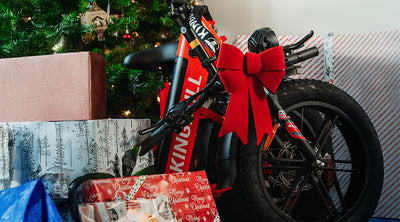
Purchase Guide
Jingle All the Way with Our Electric Bikes: The Ultimate Christmas Picks!
As the most wonderful time of the year - Christmas approaches, the air is filled with the joy of giving and the excitement of shopping. If you're still on the hunt for that perfect gift or eager to upgrade your daily commute, look no further than our sensational electric bikes. Today, we're spotlighting two extraordinary models: the sleek and portable Folding Electric Bike Literider and the reliable and stylish Commuter Electric Bike Discover.
1. Folding Electric Bike Literider: Your Compact Christmas Companion
This folding e-bike is a game-changer for urban adventurers and travel enthusiasts alike. It's not just a bike; it's a ticket to seamless mobility and effortless storage.
1. Dazzling Aesthetics
The Literider comes in four eye-catching colors: black, white, red, and green. The classic black exudes an eternal and mysterious charm, while the pure white option showcases a simple and elegant style. The vibrant red is like a raging fire in the winter, and the refreshing green adds a touch of natural vitality and energy to the riding journey. With such a diverse color palette, you can effortlessly express your unique style and stand out from the crowd.
2. Ingenious Folding Mechanism
Say goodbye to bulky transportation woes! The Literider's folding design is a work of engineering art. In a matter of seconds and without any complicated tools, it transforms into a compact package. Toss it into the trunk of your car for spontaneous weekend getaways or stow it neatly in a closet or under your office desk. It's the ultimate solution for those constantly on the move or dealing with limited living space.
3. High-Performance Capabilities
Don't let its diminutive size fool you. Beneath its sleek exterior lies a powerhouse of performance. The robust motor delivers a surge of energy, making uphill climbs a breeze and zipping through city streets with ease. The long-lasting battery ensures you can cover significant distances without constantly searching for a charging port. And with a precision gear system, you're in complete control, whether you're sprinting to catch the morning train or leisurely exploring the neighborhood.
2. Commuter Electric Bike Discover: Conquer the City Streets in Style
The Commuter Electric Bike Discover is purpose-built for the modern urbanite, promising a smooth, efficient, and enjoyable ride to and from work.
1. Sturdy and Versatile Frame Designs
The Discover offers two different frame options, each available in four fashionable colors: black, white, pink, and blue. Whether it's the metal frame with a tough style paired with the calm and imposing black or the pure and flawless white, or the lightweight aluminum alloy frame combined with the sweet and cute pink or the serene and deep blue, they are all meticulously crafted with high strength and stability. They can withstand the bumps and vibrations during daily rides, providing a solid guarantee for your riding safety. Even in the face of complex city road conditions, such as potholed roads or frequent starts and stops, the frame of the Discover can demonstrate excellent durability, accompanying you through one commute after another.
2. Captivating Color Combinations
These rich color choices enable the Discover to blend in well with the surroundings, whether in the bustling urban business district or the artistic neighborhood. The classic combination of black and white shows simplicity and professionalism; pink adds a touch of tenderness and romance to urban commuting; blue gives the ride a calm and profound atmosphere.
3. Unparalleled Comfort
We understand that comfort is key during those long commutes. The Discover features a generously padded, ergonomically designed saddle that cradles you in comfort, reducing fatigue even on extended rides. The advanced suspension system absorbs shocks and vibrations, providing a buttery-smooth ride. And with its thoughtfully crafted frame geometry, you'll maintain a natural and relaxed riding posture, minimizing strain on your back and joints.
3. Spectacular Christmas Savings!
This Christmas, we're spreading the cheer with unbeatable deals. When you purchase one of our electric bikes, you'll enjoy an instant $100 discount. But wait, there's more! If you decide to double the fun and purchase two bikes, we'll slash a whopping $250 off the total price. It's the perfect opportunity to treat yourself to a new set of wheels or surprise your loved ones with a gift that keeps on giving.
This Christmas, choose an electric bike and embrace a lifestyle of convenience, health, and eco-friendliness. Whether it's the portable charm of the Literider or the urban-ready prowess of the Discover, you can't go wrong. Don't miss out on this once-a-year Christmas promotion. Hurry and make one of our electric bikes yours today and pedal into a season of joy and adventure!
So, what are you waiting for? Let our electric bikes be the shiniest item on your Christmas shopping list and inject more vitality and surprises into this holiday season!
Read more

Kingbull News
Why Your Next E-Bike Probably Won’t Be Made of Carbon Fiber
When it comes to high-end bicycle materials, carbon fiber is often synonymous with performance and lightweight design. However, when applied to electric bikes, carbon fiber is far from mainstream—and may not even be the best choice. Here’s why your next e-bike is unlikely to feature a carbon fiber frame:
1. Weight Advantages Don’t Matter as Much in E-Bikes
Carbon fiber is prized for its ultra-lightweight properties, which significantly improve efficiency for traditional road and mountain bikes. However, e-bikes come equipped with batteries and motors that far outweigh the frame itself. Shaving off a few hundred grams from the frame won’t impact performance as much as optimizing motor power or battery capacity. In this case, the lightweight advantage of carbon fiber loses much of its appeal.
2. High Cost with Low Value for Money
Carbon fiber is an expensive material, requiring complex manufacturing processes and skilled labor. A carbon fiber e-bike can cost several times more than one with an aluminum or steel frame. Yet, the higher price doesn’t translate to a noticeable performance boost for most riders. Since e-bike buyers often prioritize value for money, carbon fiber doesn’t make the cut for most budgets.
3. High Maintenance Requirements
Carbon fiber frames demand more care than aluminum or steel ones. The material is sensitive to impacts, and even minor collisions or excessive pressure can cause cracks or structural damage that are hard to detect with the naked eye but could compromise safety.
Additionally, cleaning carbon fiber requires extra caution to avoid harsh chemicals or high-pressure washing that might damage the material. For long-term owners, the higher maintenance demands mean more time and potentially costly repairs.
4. Lower Durability and Repairability
While carbon fiber is strong, it’s less impact-resistant than other materials. A crash or accidental drop can result in cracks or breaks that are difficult—and expensive—to repair, often requiring complete frame replacement. By contrast, aluminum or steel frames are more durable and cost less to fix, making them better suited for the varied demands of e-biking.
5. Environmental and Sustainability Concerns
Producing and recycling carbon fiber is energy-intensive and poses significant environmental challenges. Its manufacturing process consumes large amounts of resources, and it’s not easily recyclable.
E-bikes are often marketed as eco-friendly alternatives to cars, but using carbon fiber undermines that narrative. Aluminum and steel, on the other hand, are easier to recycle and align better with sustainability goals by reducing carbon footprints.
6. Market Demand and Trends
Major e-bike manufacturers continue to favor aluminum and steel for their balance of affordability and practicality. Meanwhile, consumers are more focused on factors like battery range, motor performance, and ride comfort than the prestige of carbon fiber. Although carbon fiber might carve out a niche in high-end e-bike markets, it’s unlikely to dominate the broader market anytime soon.
Conclusion
While carbon fiber shines in traditional cycling, its role in e-bikes remains limited. Instead of prioritizing lightweight materials, e-bike buyers value practicality, durability, and cost-efficiency. For now, aluminum and steel frames remain the go-to choice for most e-bike manufacturers and riders.
If you’re considering your next e-bike, rather than paying a premium for carbon fiber, focus on battery life, motor power, and overall performance—these are the factors that will truly enhance your riding experience.
Read more

Tips & Cycling Knowledge
Chilly Rides: Why Your E-Bike Might Feel Sluggish in Winter
In winter, many riders notice their electric bikes don’t feel as fast or powerful as they do in warmer months. This change is influenced by factors like battery performance, motor efficiency, tire behavior, and riding conditions. Understanding these reasons can help you maintain your bike better and enjoy a safer, more comfortable ride during the colder season.
1. Battery Performance in Cold Weather
The battery is the heart of your electric bike, and it’s sensitive to temperature changes. Here’s what happens when the mercury drops:
Chemical Reaction Slowdown: Lithium-ion batteries operate best between 68°F and 77°F (20°C to 25°C). In colder weather, the chemical reactions inside the battery slow down, reducing energy output and making the ebike feel less powerful.
Increased Internal Resistance: Cold temperatures increase the battery's internal resistance, causing a greater voltage drop. This results in less power being delivered to the motor, further reducing speed.
2. Motor Efficiency in the Cold
The motor also struggles in winter conditions:
Demagnetization: If your motor has experienced wear and tear, low temperatures can worsen demagnetization, reducing its power output.
Thickened Lubricants: The lubricating oil inside the motor thickens in cold weather, increasing friction and decreasing efficiency, which slows down the ebike.
3. Tire Challenges
Winter impacts your ebike’s tires in several ways:
Lower Tire Pressure: Cold air contracts, reducing tire pressure. Lower pressure increases rolling resistance, making pedaling harder and slowing the bike.
Slippery Roads: Snow, ice, and stiff tires reduce grip, forcing us to ride cautiously.
4. Rider Adjustments
We, the riders, also adapt our behavior in winter, which affects speed:
Bundled Up: Thick winter clothing limits movement, making it harder to ride efficiently.
Safety First: Slippery roads and poor visibility encourage slower speeds to avoid accidents.
5. Controller’s Protection Mechanism
Your bike’s controller has a low-voltage protection setting to safeguard the battery. In winter, the battery drains faster due to reduced performance, hitting this threshold sooner. When that happens, the controller limits power output, further slowing down your ebike.
Embracing Winter Riding
While it can be frustrating that your electric bike isn’t as zippy in winter, these slower rides can still be enjoyable. Take the opportunity to:
Admire the winter scenery.
Adjust your riding style for safety.
Take care of your battery by keeping it warm before riding.
Understanding why your ebike behaves differently in the cold helps you adapt and make the most of your winter rides. So, bundle up, ride safe, and share your winter cycling adventures with fellow riders. Happy pedaling!
Read more
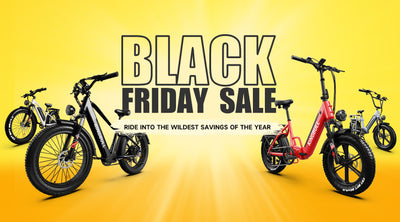
Purchase Guide
Black Friday Sale: Unbeatable Deals on Electric Bikes – Start Your New Riding Adventure Now!
The annual Black Friday shopping bonanza is here! For many, this means snagging some of the best deals of the year. If you’ve been on the hunt for an eco-friendly, efficient mode of transportation, now is the perfect time to make your move. This year, we’re offering unmissable discounts on electric bikes, helping you ride further and live smarter.
Why choose an Electric Bike? Here’s Why It’s the Best Decision You’ll Make
Electric bikes (e-bikes) are not just fast and convenient for urban commuting – they’re a smart, eco-friendly choice for all kinds of riders. Whether you’re commuting, taking weekend rides, or going on an outdoor adventure, an electric bike is designed to handle it all, providing a smooth, enjoyable experience. Plus, choosing an e-bike means saying goodbye to gas-powered vehicles, lowering your carbon footprint, and saving big on gas and parking.
Benefits of Riding an Electric Bike:
Eco-Friendly: E-bikes run on electricity, cutting down on CO2 emissions and contributing to a cleaner, healthier planet.
Low-Cost: Charging an e-bike is a fraction of the cost of fueling a car, and the maintenance is much cheaper too.
Convenience: Skip traffic jams and parking hassles. E-bikes let you ride wherever you need to go – quickly and easily.
Black Friday Exclusive: Huge Discounts + Free Gifts, Limited Time Only!
In celebration of Black Friday, we’ve put together an incredible electric bike sale! Get your hands on a high-quality e-bike for a fraction of the price, plus enjoy exclusive gifts, but hurry – these deals won’t last long!
1. Massive Discounts, Save Up to $2000
During the Black Friday sale, we’re offering $600–$900 off on all e-bike models! Plus, if you buy any two e-bikes, you’ll automatically get an extra $200 off. Whether you’re looking for a sleek commuter bike or a rugged off-road e-bike for weekend adventures, now’s the time to grab one at an unbeatable price.
2. Free Gift Package Worth Over $300
Every electric bike purchase comes with a free gift package, which varies depending on the model. These gift packages are worth up to $473 and include must-have accessories like a phone holder, front basket, passenger seat cushion, front bag, and bike cover. These accessories will make your rides safer and more comfortable.
How to Choose the Right Electric Bike for You
When shopping for an electric bike, it’s important to consider your riding needs and preferences. Here are a few things to think about:
1. Commuting or Leisure Riding?
Commuting Needs: If you’re looking for an efficient way to commute around the city, a folding electric bike is a great option. They’re compact, lightweight, and easy to store.
Leisure Riding: If you love weekend getaways and exploring nature, a full-suspension or off-road electric bike is perfect for tackling rough terrain and longer rides.
2. Carrying Capacity
Need to Haul Gear? If you plan to carry heavy loads or want to ride with family members, a cargo electric bike is ideal. These bikes are designed to carry more weight comfortably, making them great for longer trips and family rides.
3. Comfort Matters
Many electric bikes come with wide, comfortable seats and shock-absorbing systems that make for a smooth ride – even on bumpy roads. Look for bikes that offer a comfortable, enjoyable riding experience.
Save Money and Help the Environment: The Dual Benefits of Electric Bikes
In today’s world, eco-friendliness and cost savings are more important than ever. Choosing an electric bike is not only a great way to reduce your environmental impact, but it will also save you money in the long run.
How Electric Bikes Help You Save:
No Gasoline Needed: Charging an electric bike is a fraction of the cost of filling up a gas tank.
No Parking Fees: Skip expensive parking fees – e-bikes are easy to park anywhere.
Low Maintenance Costs: Electric bikes require far less maintenance than cars, meaning fewer trips to the shop and lower upkeep costs.
Don’t Miss Out – Grab Your Electric Bike This Black Friday!
The Black Friday sale is here, offering unbeatable discounts for a limited time. Whether you’re upgrading your commute or choosing a more eco-friendly lifestyle, now’s the perfect time to grab the electric bike that fits your needs. Don’t miss out—take advantage of these amazing deals and start enjoying a healthier, more sustainable ride today. There’s no better time to buy than now!.
Click here to shop the Black Friday electric bike sale and grab your exclusive discounts!
Read more

Kingbull NewsPurchase Guide
Family, Holidays, and Shared Moments: Why an Electric Bike is the Best Gift This Black Friday
Black Friday is one of the biggest shopping events of the year in the U.S., packed with great deals and exciting opportunities. This year, Black Friday is not just a chance to shop for yourself, but also the perfect time to pick out special gifts for family and friends. If you’re struggling to find the perfect gift for the holidays, an electric bike could be the practical and meaningful choice you’ve been looking for. Not only will it bring more fun and enjoyment to you and your family, but it also offers a great way to spend more time outdoors this winter, strengthening bonds and creating lasting memories.
1. Family-Friendly Electric Bikes: Fun for All Ages
Many American families take advantage of Black Friday deals to buy big-ticket items, and an electric bike is an ideal option that meets the needs of multiple generations. From young kids 01to older parents, the versatility of an electric bike makes it perfect for family outings, vacations, and even daily commutes. It allows parents to stay active outdoors, while also providing young riders with an exciting and easy biking experience.
Family Rides Made Easy: Whether it’s cycling to the park or taking a weekend ride to a nearby lake, an electric bike can add more joy to your family activities. Unlike traditional bikes, electric bikes offer pedal assistance, making it easier for everyone to enjoy longer rides without worrying about tiring out.
Perfect for All Ages: From design to functionality, Kingbull electric bikes are built to accommodate riders of all ages and sizes. Modern e-bikes feature adjustable seats and handlebars, ensuring that both parents and kids can enjoy a comfortable ride.
2. Electric Bikes: The Perfect Holiday Gift
Giving an electric bike as a gift is not only practical, but it also shows you care about the health and well-being of your loved ones. While many people receive digital gadgets or clothing as gifts during the holidays, an electric bike stands out as a thoughtful and meaningful option.
For the Cycling Enthusiast: If you have a family member who loves cycling, an electric bike is the ultimate upgrade. It provides a smoother, more effortless riding experience and allows them to stay outdoors and active for longer. For those who enjoy adventure and travel, an electric bike is the perfect companion for exploring new places.
A Gift That Combines Health and Sustainability: As environmental awareness grows, many people are opting to reduce their reliance on gas-powered cars. Kingbull electric bikes are an eco-friendly choice, reducing carbon emissions, while also promoting better health through physical activity. Giving one as a holiday gift shows you care about both your loved one’s well-being and the planet’s future.
3. Create Shared Memories with an Electric Bike
The holidays are a time for families to come together and enjoy quality time. Choosing an electric bike as a gift isn’t just about buying a product—it’s about giving your family the opportunity to create more shared experiences.
Making Memories Together: Riding electric bikes with your family to a nearby nature park or along a scenic beach path not only lets you enjoy the beauty of nature, but also deepens family connections in a fun and relaxed way. In today’s busy world, spending quality time with loved ones has become increasingly rare, and an electric bike makes it easy to turn those moments into lasting memories.
Holiday Riding Fun: Whether it’s Christmas or the start of the New Year, Kingbull electric bikes can bring the whole family together to enjoy outdoor activities. Cycling is an activity that can be enjoyed by all ages, and with the added power of pedal assist, it’s accessible to everyone in the family. It’s the perfect way to share the joy of exercise and outdoor fun.
4. Black Friday Exclusive Deals: Bring Home More Discounts and Rewards
To celebrate this Black Friday shopping season, we’ve prepared exclusive offers just for families. During this event, when you buy any two electric bikes, you’ll receive up to $200 off, plus multiple free accessories to make your family’s cycling experience even better!
Promotion Details:
Buy two electric bikes and save an additional $200
Get a free Black Friday Riding Kit, worth up to $473
Act now and make an electric bike the best gift for your family this Black Friday! Don’t miss out—grab your favorite e-bike and enjoy the holiday season to the fullest.
Conclusion
This Black Friday, an electric bike isn’t just a great purchase for yourself—it’s the perfect way to bring more joy and meaningful moments to your family. Whether it’s sharing the fun of cycling together or giving a thoughtful gift to a loved one, an electric bike should be at the top of your holiday shopping list. Let this winter be the time you and your family ride together and create unforgettable memories!
Read more







